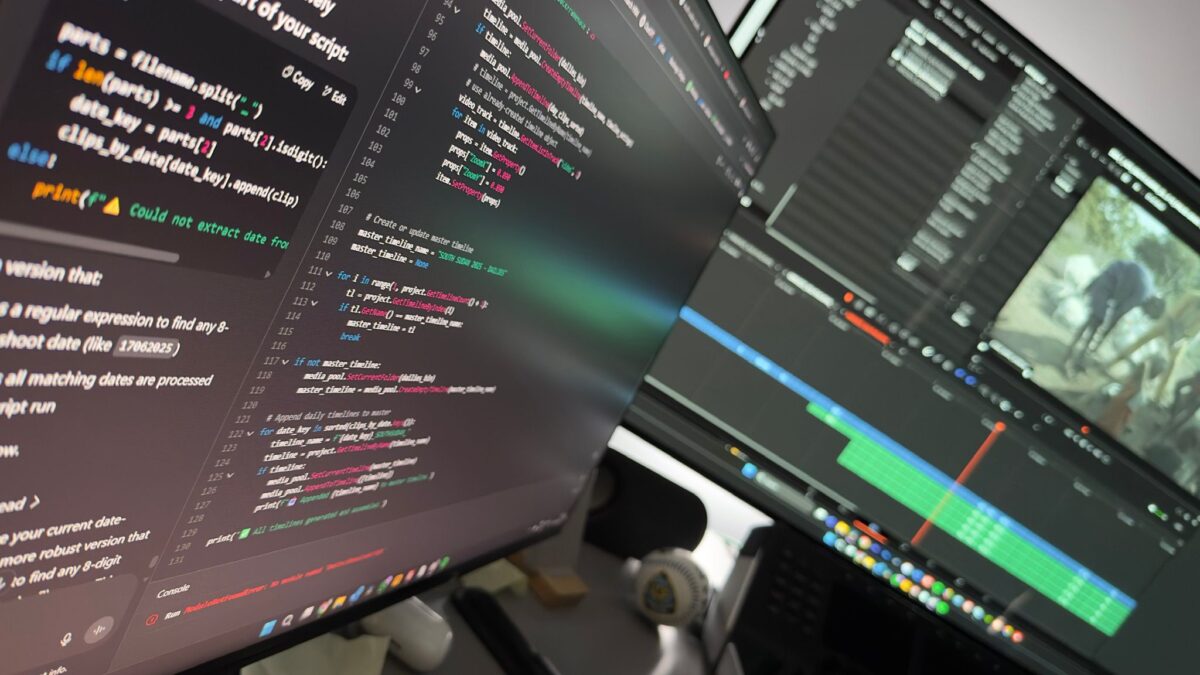How I Built My First Python Script – Resolve
DaVinci Resolve Python automation is transforming how I handle large documentary projects. As a colorist and post-production specialist managing 20 – 30 edits a year, I needed a faster way to organize footage. So I built a custom Python script that automatically creates daily timelines inside Resolve – saving hours on every project.
This post is a behind-the-scenes look at how I created a custom Python script for DaVinci Resolve to automate the creation of daily timelines – a small tool that’s already saving me hours on every project.
Why I Built It
Every project I work on – mostly documentaries – begins with an overwhelming amount of material: full-resolution camera originals, drone footage, action cams, field audio, backups, proxies, and dailies. Before editing or grading begins, I need to organize this chaos.
My usual process looked like this:
-
Sort clips by shooting date
-
Create one timeline per filming day
-
Place clips in chronological order
-
Apply temporary zooms or framing
-
Build a master timeline from all the daily timelines
This is the kind of work that’s necessary but time-consuming and repetitive. It doesn’t require creativity – just precision and consistency. And that’s exactly the kind of thing scripts are perfect for.
The Goal
I wanted a script that could:
-
Scan a bin (and its sub-bins) in Resolve
-
Filter out audio and stills
-
Extract shoot dates from filenames (in format
DDMMYYYY) -
Group clips by date
-
Create one UHD timeline for each date (named with a country code like
SSD_21-05-2025) -
Apply default framing or zoom if needed
-
Build a master timeline with all daily timelines combined, in order
This might sound small, but across 12 to 15 films a year – many of them shot in remote locations – it’s a game-changer.
My Workflow Context
We use Canon R5C as the main camera, with DJI drones and Osmo cams as support. Audio usually comes from Zoom F6 or H4E recorders. Filming happens across Africa, the Middle East, and Asia. The project structure follows a clear naming convention, and everything is logged by country code – like SSD for South Sudan.
The dailies workflow lives in a DaVinci Resolve project dedicated to each trip. This is where OCF is synced, looks are applied, and editorial begins. I wanted my script to drop straight into that stage – no extra tools or software.
Writing the Script
I had never written a Resolve script before, but I’ve been working in post long enough to know exactly what I needed. So I started small.
Using the official DaVinci Resolve Python API, I:
-
Connected to the current open project
-
Accessed the Media Pool and found the active bin
-
Recursively searched all sub-bins for video clips
-
Used Python’s
remodule to extract an 8-digit date from each clip’s filename -
Grouped clips by those dates
-
Created UHD timelines for each group, sorted chronologically
-
Appended clips in timeline order
-
Finally, created a new “Master” timeline that pulls all the daily timelines together
Each timeline is named using the country code and shoot date – so for example: SSD_21-05-2025. This format helps keep everything traceable and consistent throughout the project.
Challenges
The hardest part wasn’t writing the logic – it was understanding how Resolve’s API thinks. The documentation is minimal. There’s no undo. And it’s easy to accidentally generate 20 empty timelines if you misplace a bracket.
Debugging meant running the script again and again, checking bins, testing naming rules, and dealing with inconsistent metadata (for example, some clips didn’t have any date info in filenames). I had to write fallback conditions to skip those or log them for manual review.
One mistake could overwrite a bin or generate dozens of timelines with no clips. So I added logging, error checks, and limits to how many timelines can be generated at once.
The Result
Now, instead of manually building dailies timelines for every project, I just:
-
Import the OCF
-
Run the script
-
Check the timelines
Within seconds, I get:
-
Clean UHD timelines for each shoot day
-
All clips arranged by filename date
-
A master sequence of the entire trip
It’s fast, consistent, and eliminates the human error that creeps in during repetitive manual work – especially late at night during crunch time.
Why It Matters
As post-production specialists, we’re often juggling tech and creativity. Automating low-value, high-effort tasks like this gives me more space to focus on the parts that matter: color, story, rhythm, and tone.
This script doesn’t replace judgment – I still check every timeline before sending it out. But it gives me structure fast, and that structure lets me work smarter, not just faster.
It also brings a level of repeatability to my pipeline. Whether I’m working on a campaign for South Sudan or a film from Pakistan, the initial timeline setup is now always clean and consistent.
What’s Next
Need a custom Python script to automate your DaVinci Resolve workflow? Share your challenge — I’ll build a tool that saves you time and keeps your post-production moving smoothly.



